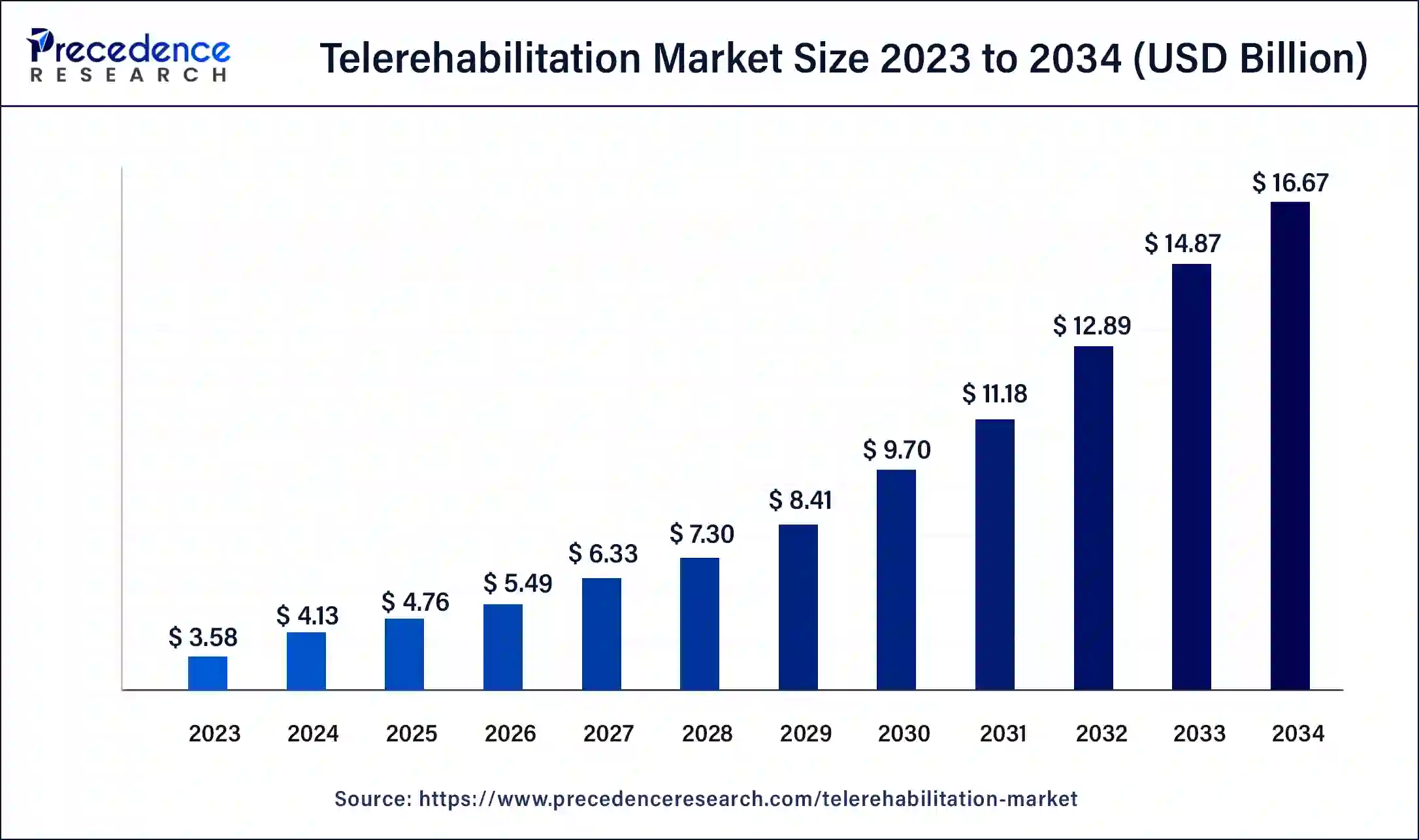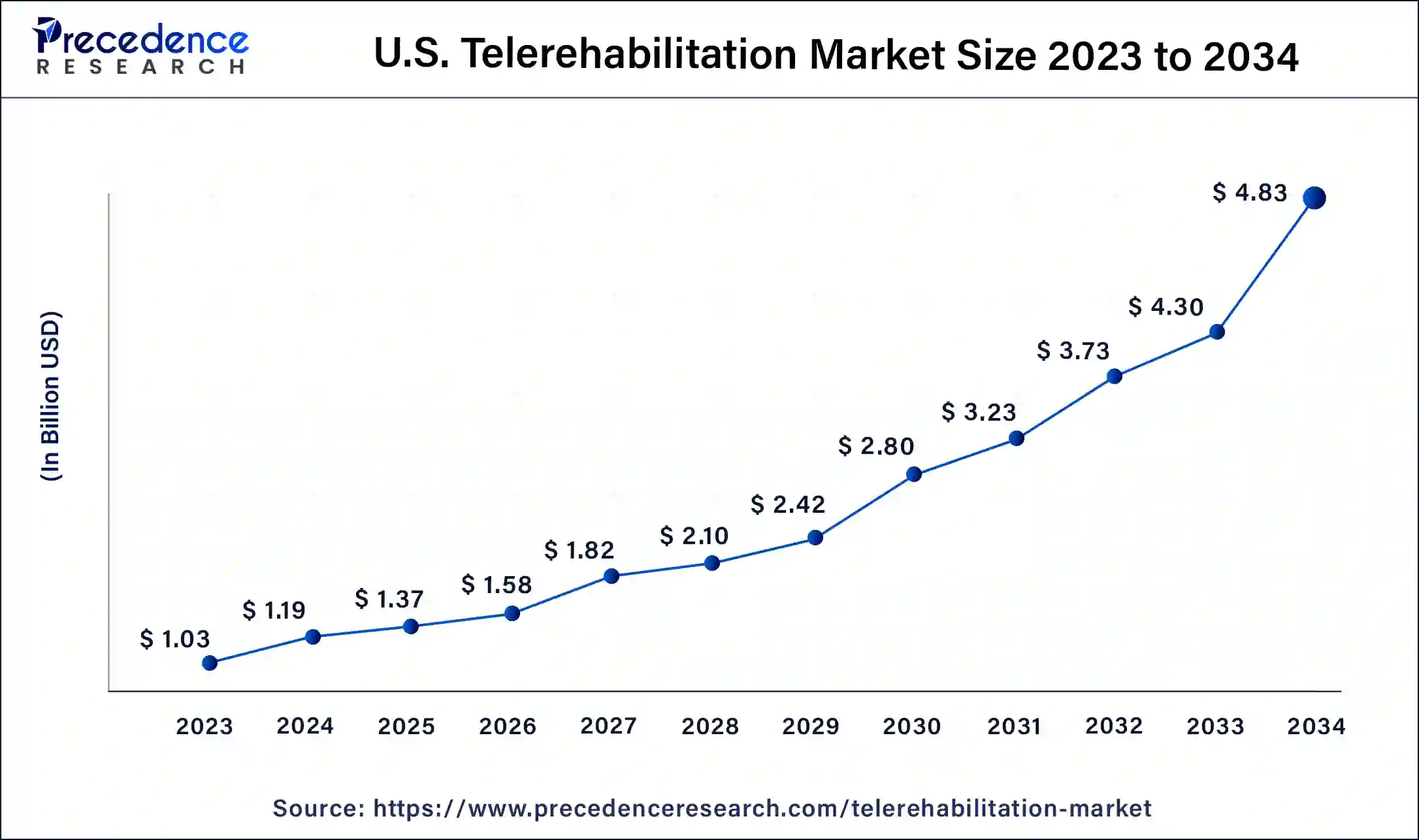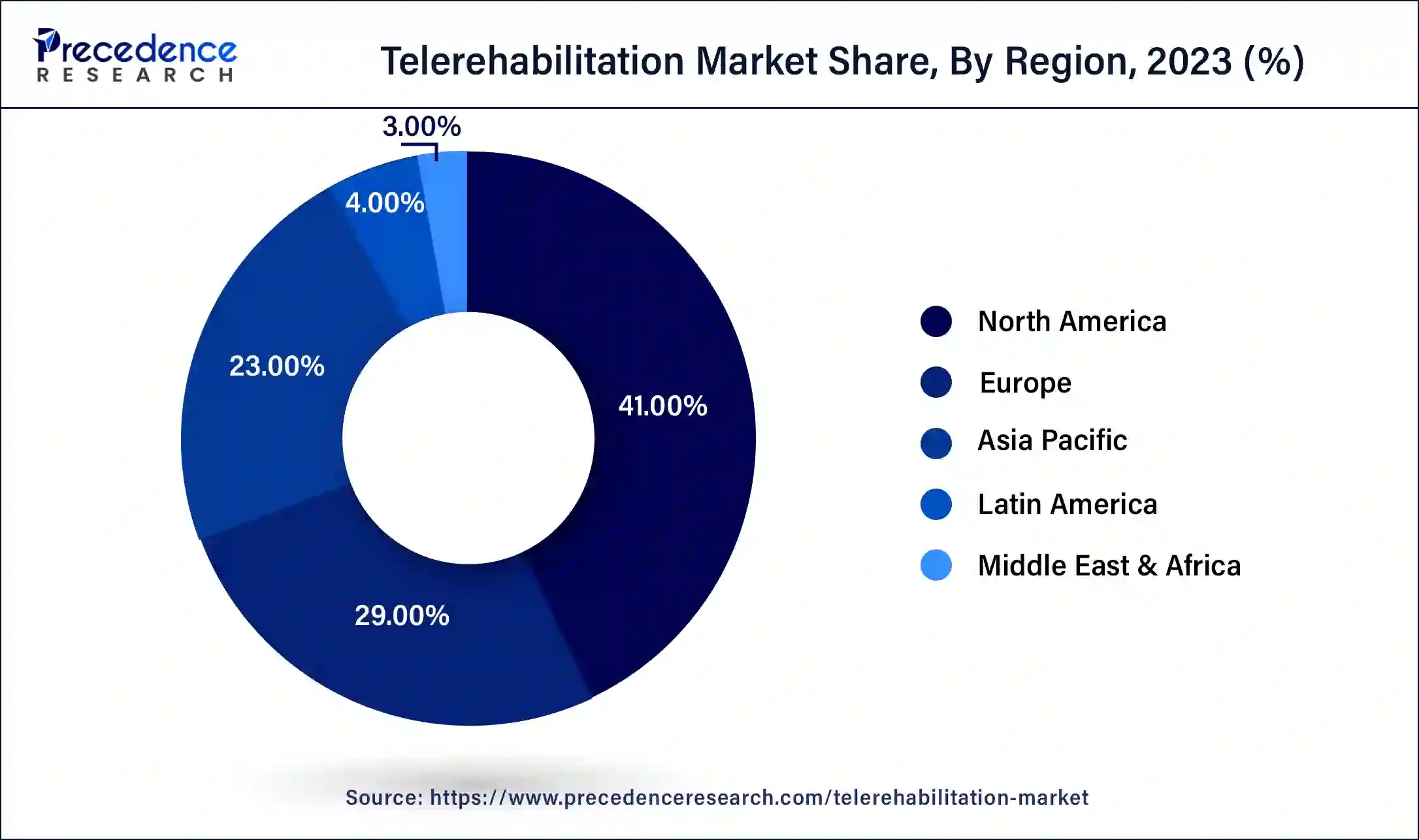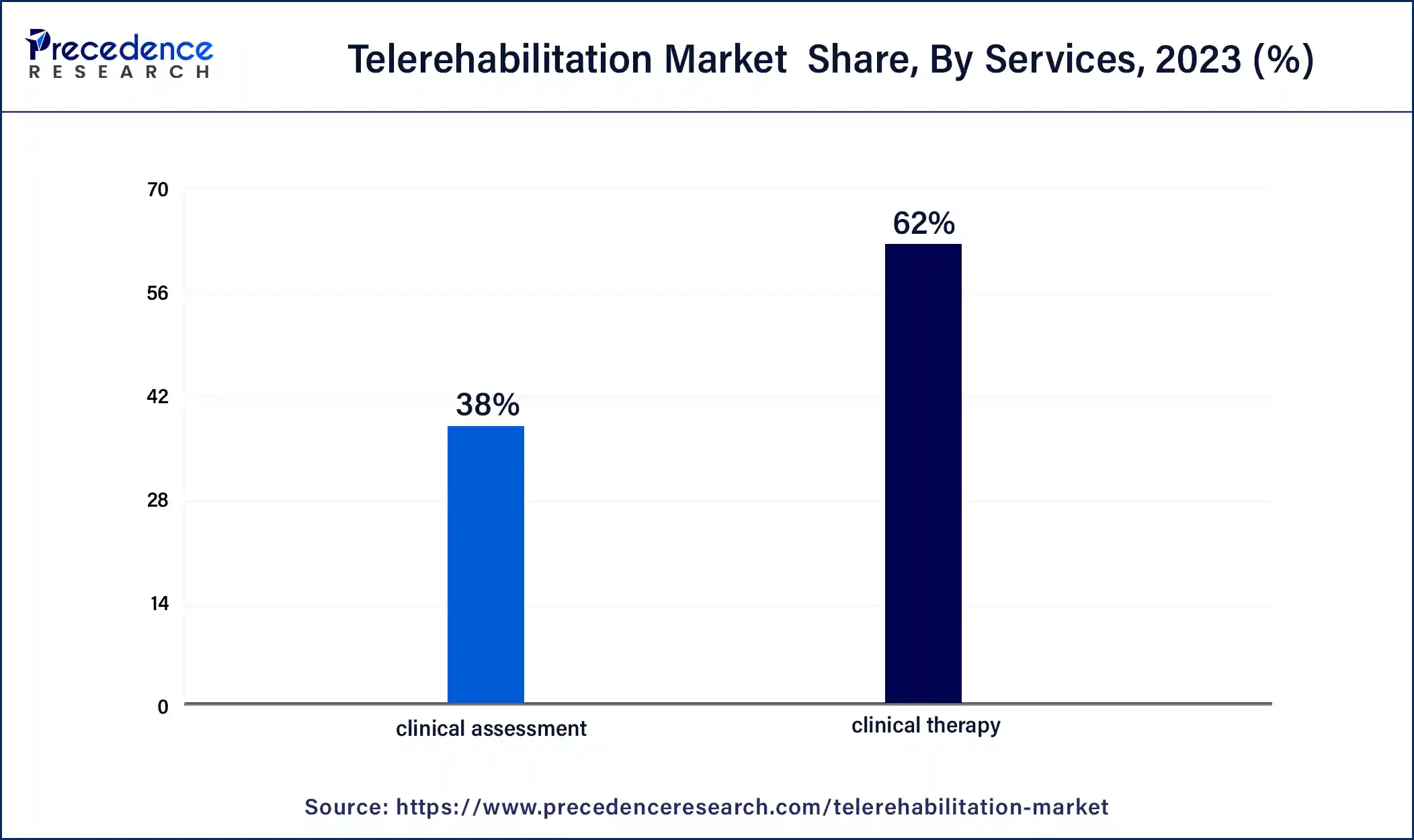The global telerehabilitation market size was USD 3.58 billion in 2023, estimated at USD 4.13 billion in 2024 and is anticipated to reach around USD 16.67 billion by 2034, expanding at a CAGR of 16.67% from 2024 to 2034.
The global telerehabilitation market size accounted for USD 4.13 billion in 2024 and is predicted to reach around USD 16.67 billion by 2034, growing at a CAGR of 16.67% from 2024 to 2034.

The U.S. telerehabilitation market size was valued at USD 1.03 billion in 2023 and is expected to be worth around USD 4.83 billion by 2034, at a CAGR of 15.30% from 2024 to 2034.

North America has held the largest revenue share of 41% in 2023. North America dominates the telerehabilitation market due to a convergence of factors. The region boasts advanced healthcare infrastructure, widespread adoption of digital health technologies, and supportive regulatory frameworks promoting telehealth services. Additionally, a high prevalence of chronic conditions and the COVID-19 pandemic have accelerated the acceptance of remote healthcare. Favorable reimbursement policies and robust investment in telehealth further propel North America's leadership in the telerehabilitation market, making it a key contributor to the region's major market share.

Asia-Pacific is estimated to witness highest growth. The Asia-Pacific region holds a major share in the telerehabilitation market due to factors like rapid technological adoption, increasing prevalence of chronic diseases, and a vast population with limited access to traditional healthcare services. The region's expansive telecommunication infrastructure, coupled with supportive government initiatives and rising awareness, has propelled the widespread acceptance of telerehabilitation. Additionally, the geographical diversity and remote healthcare needs in countries across Asia-Pacific make telerehabilitation a particularly practical and accessible solution, contributing to the region's dominant position in the market.
Telerehabilitation is an innovative healthcare approach that utilizes technology to deliver rehabilitation services remotely. This method employs tools like video conferencing, mobile applications, and wearable devices, allowing healthcare professionals to assess, monitor, and provide tailored rehabilitation interventions to individuals recovering from diverse health conditions, ranging from injuries to chronic illnesses.
This modern approach brings several benefits, including increased patient engagement, minimized travel challenges, and improved continuity of care. Patients can conveniently access personalized rehabilitation exercises, receive real-time feedback, and engage in virtual consultations with therapists from the comfort of their homes. Telerehabilitation, while not a complete substitute for traditional in-person rehabilitation, serves as a valuable supplement, fostering flexibility and patient-centered healthcare solutions. With advancing technology, telerehabilitation is poised to play a pivotal role in optimizing rehabilitation services, offering a promising avenue for expanding access to high-quality care.
| Report Coverage | Details |
| Growth Rate from 2024 to 2034 | CAGR of 14.97% |
| Market Size in 2023 | USD 3.58 Billion |
| Market Size in 2024 | USD 4.13 Billion |
| Market Size by 2034 | USD 16.67 Billion |
| Largest Market | North America |
| Base Year | 2023 |
| Forecast Period | 2023 to 2034 |
| Segments Covered | Component, Services, Therapy, and Region |
| Regions Covered | North America, Europe, Asia-Pacific, Latin America, and Middle East & Africa |
Increasing patient demand and technological advancements
The surge in the telerehabilitation market is propelled by the dual forces of increasing patient demand and rapid technological advancements. As patients increasingly seek accessible and convenient healthcare options, the demand for Telerehabilitation rises. Patients, empowered by a preference for remote services, particularly in the aftermath of the COVID-19 pandemic, are driving the need for flexible rehabilitation solutions that transcend geographical constraints.
Simultaneously, technological advancements play a pivotal role in shaping the Telerehabilitation landscape. Innovations in telecommunication technologies, virtual reality, and wearables are transforming the delivery and effectiveness of rehabilitation services. These technologies not only facilitate remote consultations but also enable real-time monitoring and personalized interventions, enhancing the overall patient experience. The synergy between heightened patient demand and cutting-edge technology creates a dynamic market environment, positioning Telerehabilitation as a key player in modern healthcare solutions.
Digital divide and regulatory challenges
The telerehabilitation market faces notable restraints in the form of the digital divide and regulatory challenges. The digital divide, marked by disparities in internet access and digital device availability, creates a substantial barrier to the widespread adoption of telerehabilitation services. Communities without reliable connectivity and access to digital tools may find it challenging to benefit from remote rehabilitation, exacerbating healthcare inequalities. Additionally, regulatory challenges contribute to the restraint of the Telerehabilitation market.
The complex and evolving nature of healthcare regulations across different regions introduces hurdles in achieving consistent implementation. Compliance issues and varying standards can impede the seamless integration of telerehabilitation into established healthcare systems, slowing down its acceptance and adoption. Addressing these challenges through policy advocacy, infrastructure development, and regulatory alignment is crucial for unlocking the full potential of telerehabilitation and ensuring equitable access to rehabilitation services for all.
Global expansion of telehealth policies and rising acceptance of remote healthcare
The global expansion of telehealth policies and the rising acceptance of remote healthcare are pivotal factors creating significant opportunities in the Telerehabilitation market. As countries worldwide embrace telehealth as a standard component of healthcare delivery, favorable regulatory environments are emerging, paving the way for the seamless integration of telerehabilitation services. The alignment of policies with the broader telehealth landscape fosters a conducive atmosphere for market growth, encouraging healthcare providers to incorporate remote rehabilitation solutions into their offerings.
Simultaneously, the increasing acceptance of remote healthcare, accelerated by the widespread adoption of telehealth during the COVID-19 pandemic, establishes a favorable climate for Telerehabilitation market expansion. Patients and healthcare professionals are becoming more comfortable with virtual interactions, opening doors for telerehabilitation to address rehabilitation needs remotely. This acceptance not only boosts the market's growth potential but also underscores the transformative role telerehabilitation can play in delivering accessible and patient-centric rehabilitation services on a global scale.
In 2023, the software segment held the highest market share of 60% on the basis of the component. In the telerehabilitation market, the software segment encompasses the digital tools and applications essential for delivering remote rehabilitation services. This includes telehealth platforms, virtual exercise programs, and data analytics systems that enable healthcare professionals to monitor patient progress.
Recent trends in telerehabilitation software focus on user-friendly interfaces, interoperability with electronic health records, and the integration of artificial intelligence for personalized treatment plans. The evolving landscape emphasizes the development of innovative software solutions that enhance the overall efficiency, accessibility, and effectiveness of remote rehabilitation programs.
The hardware segment is anticipated to witness highest growth at a significant CAGR of 18.4% during the projected period. In the Telerehabilitation market, the hardware segment encompasses the physical devices and equipment essential for delivering remote rehabilitation services. This includes specialized sensors, wearable devices, video conferencing tools, and other interconnected hardware components designed to facilitate real-time communication, data collection, and monitoring during virtual rehabilitation sessions.
A growing trend in this segment involves the development of more advanced and user-friendly hardware solutions, such as motion sensors and wearable tech, to enhance the accuracy of patient data collection, foster greater patient engagement, and improve overall telerehabilitation effectiveness.
According to the services, the clinical therapy segment has held a 62% revenue share in 2023. Clinical therapy in the Telerehabilitation market refers to remote delivery of therapeutic interventions by healthcare professionals, covering a spectrum of services such as physical therapy, occupational therapy, and speech-language pathology. Trends in this segment include the increasing use of virtual platforms for personalized rehabilitation sessions, the integration of wearable devices for real-time monitoring, and the development of interactive applications that facilitate patient engagement. The clinical therapy segment is evolving to offer comprehensive and effective remote rehabilitation solutions, aligning with the broader shift towards telehealth in healthcare delivery.

The clinical assessment segment is anticipated to witness highest growth over the projected period. In the telerehabilitation market, the clinical assessment segment involves remote evaluations of patients' physical, cognitive, and functional abilities by healthcare professionals using digital platforms. This service allows practitioners to assess and diagnose conditions, formulate personalized rehabilitation plans, and monitor progress through virtual interactions.
A notable trend in this segment includes the integration of advanced technologies, such as motion sensors and artificial intelligence, to enhance the accuracy of clinical assessments, providing more precise insights into patients' rehabilitation needs and optimizing the overall efficacy of telerehabilitation services.
According to the therapy, the physical therapy segment has held 42% revenue share in 2023. The physical therapy segment in the telerehabilitation market involves delivering rehabilitation services remotely, focusing on exercises and interventions aimed at improving physical function. This includes personalized exercise programs, injury recovery, and musculoskeletal rehabilitation conducted through virtual consultations.
A notable trend in this segment is the increasing integration of wearable devices and motion-tracking technologies, enhancing real-time monitoring of patient movements. These innovations enhance the effectiveness of virtual physical therapy sessions, providing valuable insights for therapists and fostering patient engagement in their rehabilitation journeys.
The occupational therapy segment is anticipated to witness highest growth over the projected period. Occupational therapy within the Telerehabilitation market involves remotely delivering therapeutic interventions to enhance individuals' ability to engage in daily activities. This includes virtual assessments, personalized goal-setting, and interactive interventions aimed at improving functional skills.
A notable trend in telerehabilitation's occupational therapy segment is the increasing integration of digital tools, such as virtual reality and wearable devices, to provide engaging and effective therapeutic experiences. This technology-driven approach enhances accessibility and patient engagement while maintaining the core principles of occupational therapy in a virtual environment.
Segments Covered in the Report
By Component
By Services
By Therapy
By Geography
For inquiries regarding discounts, bulk purchases, or customization requests, please contact us at sales@precedenceresearch.com
No cookie-cutter, only authentic analysis – take the 1st step to become a Precedence Research client